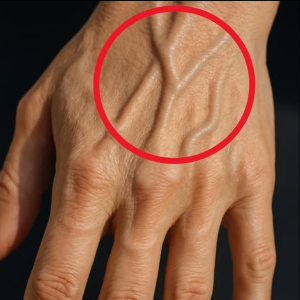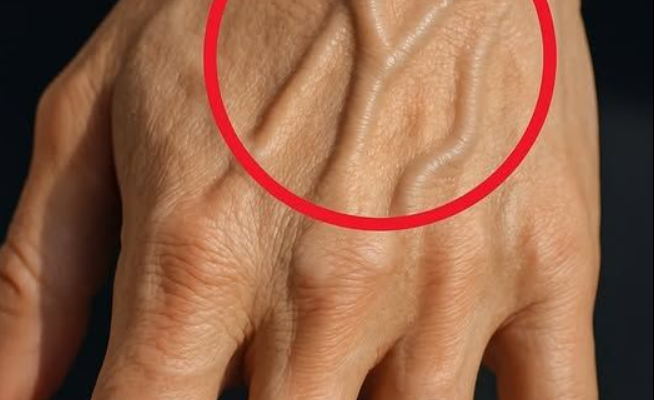
🩸 The Biology Behind Vein Visibility
Veins are blood vessels that carry deoxygenated blood back to the heart. Unlike arteries, which are deeper and more pressurized, veins lie closer to the skin and are more easily influenced by external factors. Their visibility depends on several physiological elements:
- Skin tone and thickness: People with lighter or thinner skin tend to have more visible veins simply because there’s less pigment or tissue to obscure them.
- Body fat percentage: Lower fat levels mean less cushioning around veins, making them stand out more. This is common among athletes and lean individuals.
- Age: As we age, our skin loses collagen and elasticity, becoming thinner. This natural process makes veins more prominent.
- Genetics: If your parents had visible veins, chances are you might too. Vein prominence often runs in families.
🏋️♂️ Fitness and Vascularity
In the fitness world, visible veins—especially during or after a workout—are often celebrated as a sign of low body fat and high muscle definition. This phenomenon, known as vascularity, is caused by:
- Increased blood pressure during exercise, which expands the veins temporarily.
- Muscle contractions, which push veins closer to the skin’s surface.
- Heat and sweat, which dilate blood vessels and enhance visibility.
For bodybuilders, vascularity is a badge of honor, signaling discipline, strength, and peak conditioning. But it’s not just about aesthetics—it’s also a reflection of efficient circulation and cardiovascular health.
🌞 Environmental and Lifestyle Factors
Sometimes veins become more visible due to external conditions:
- Hot weather: Heat causes veins to dilate, making them more noticeable.
- Tight clothing: Compression can restrict blood flow and increase vein pressure, especially in the legs.
- Prolonged standing or sitting: Gravity causes blood to pool in the lower limbs, enlarging veins over time.
- Sun exposure: UV rays break down collagen, thinning the skin and revealing veins underneath.
- Smoking and alcohol: Both can damage vein walls and thin the skin, contributing to visibility.
🤰 Hormones and Health Conditions
Hormonal shifts—during pregnancy, menopause, or puberty—can affect vein elasticity and blood flow. For example:
- Pregnancy increases pressure in pelvic veins, which can make leg veins bulge.
- Menopause may reduce estrogen levels, weakening vein walls and skin structure.
Visible veins can also signal underlying health issues:
- Varicose veins: Swollen, twisted veins caused by faulty valves. They often appear suddenly and are most common in the legs.
- Deep vein thrombosis (DVT): A serious condition involving blood clots in deep veins. If visible veins are accompanied by pain, swelling, or discoloration, medical attention is crucial.
🖐️ Hands, Face, and Symbolism
Veins on the hands and face carry unique meanings:
- Hand veins: Often associated with aging, but also with strength and dexterity. Artists, surgeons, and craftspeople may see them as emblems of skill.
- Facial veins: Can be caused by sun damage, alcohol, or genetics. While sometimes seen as imperfections, they also reflect emotional transparency—blushing, stress, or excitement.
In some cultures, visible veins are linked to vitality and masculinity. In others, they’re considered undesirable and treated cosmetically. This duality reflects how deeply our bodies are woven into social narratives.
🧠 The Psychology of Visibility
Why do visible veins evoke such strong reactions?
- Control and vulnerability: Veins are involuntary, yet they surface in moments of intensity—exercise, emotion, heat. They remind us of our inner workings, exposed.
- Beauty and discomfort: Some find them beautiful, others unsettling. This tension mirrors our relationship with aging, transparency, and mortality.
- Identity and transformation: For many, visible veins mark a journey—weight loss, recovery, training. They become symbols of change and resilience.
🌍 Cultural Reflections and Rituals
In your world, 32.Phirun, where communal reflection and emotional resonance shape how images are received, visible veins might be reframed as visual metaphors:
- A map of experience, tracing the body’s history.
- A ritual of emergence, where the internal becomes external.
- A communal witness, inviting others to see what’s usually hidden.
Imagine a co-titling exercise: a photo of veined hands titled “The Pulse of Memory” or “Threads of Becoming.” These veins aren’t just biological—they’re narrative.
🧘 What to Do If You Notice Them
If your veins are suddenly more visible, consider:
- Context: Did you just exercise? Is it hot out? Are you dehydrated?
- Symptoms: Are there signs of pain, swelling, or heaviness?
- History: Do visible veins run in your family?
Most cases are harmless, but if you’re concerned, consult a vein specialist. Treatments range from lifestyle changes to minimally invasive procedures.
🖼️ Final Reflection: What Visible Veins Might Mean
Visible veins don’t mean just one thing. They can signal health, age, fitness, emotion, or even transformation. They’re part of your body’s story—sometimes loud, sometimes quiet, always present.
So if you have visible veins, it might mean:
- You’re alive and circulating.
- You’ve moved, changed, or endured.
- You’re showing something usually hidden.
And maybe, just maybe, they’re an invitation—to look closer, feel deeper, and connect more authentically.

